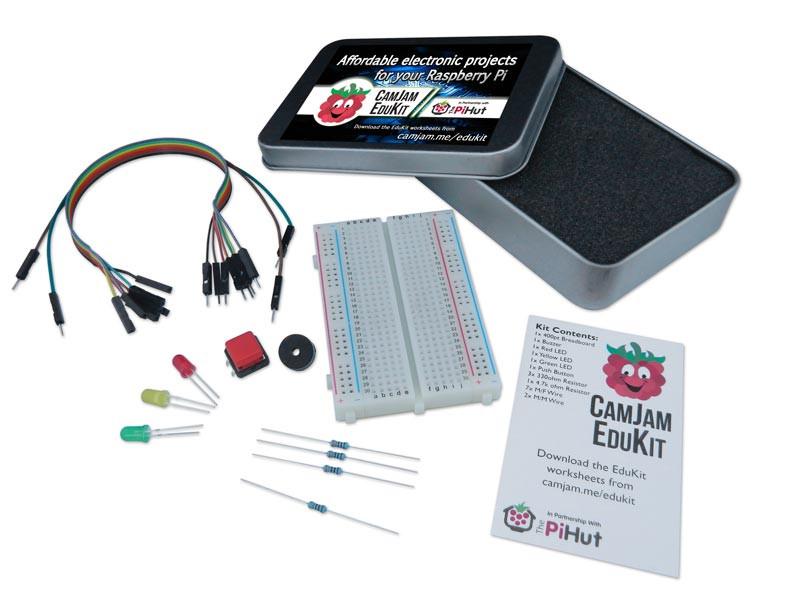Contents of CamJam EduKit 1

It contains the following components, all neatly packaged in a project tin:
- A 400-point breadboard
- 3 LEDs (Red, Yellow and Green)
- A button
- A buzzer
- Resistors
- Jumper cables
You will need to provide the following
- A board to use with the kit:
- A Raspberry Pi (any version, including the Raspberry Pi Zero) SD card and power supply
- or a Raspberry Pi Pico (any version – you may need to solder your own header pins) plus 4 additional M-M jumper wires.
- You can get these boards from many different suppliers, but we recommend using one of the authorised resellers.
- A keyboard and mouse. (Using a Pi Zero may require a USB hub and/or adapter to allow you to work with it).
Buying CamJam EduKit 1
CamJam EduKit 1 is available to purchase from The Pi Hut.
Download the worksheets
The CamJam EduKit worksheets use the Python programming language with the GPIO Zero library (for the Raspberry Pi) or MicroPython with the picozero library (if you are working with the Raspberry Pi Pico).
For the Regular Raspberry Pi
The following worksheets are suitable for use with Raspberry Pi microcomputers such as the Raspberry Pi 3+, 4 etc. Please make sure to read the instructions carefully for any notes relevant to your particular model.
We also have some un-tested scripts for Scratch available.
- Worksheet 1 – Introduction
- Worksheet 2 – LEDs
- Worksheet 3 – Blinking LEDs
- Worksheet 4 – User Input
- Worksheet 5 – Button
- Worksheet 6 – Buzzer
- Worksheet 7 – Traffic lights
- Worksheet 8 – Games
For the Raspberry Pi Pico
The following worksheets are suitable for use with Raspberry Pi Pico microcontrollers such as the Pico, Pico W, Pico H etc. A massive Thank You to Simon9933 who did much of the work to convert the worksheets for the Pico.
Please make sure to read the instructions carefully for any notes relevant to your particular model, especially when it comes to updating the Pico’s firmware.
- Worksheet 1 – Introduction
- Worksheet 2 – LEDs
- Worksheet 3 – Blinking LEDs
- Worksheet 4 – User input
- Worksheet 5 – Button
- Worksheet 6 – Buzzer
- Worksheet 7 – Traffic lights
- Worksheet 8 – Games
Download everything
You can download all the worksheets and all the code from GitHub by using the following command on the Raspberry Pi:
git clone https://github.com/CamJam-EduKit/EduKit1
Licence
All CamJam EduKit worksheets are covered by a Creative Commons licence. CC-BY-NC-SA
The original Word document versions for both the regular Pi and the Pico are available for re-use or translation by contacting us.

Comments are closed.